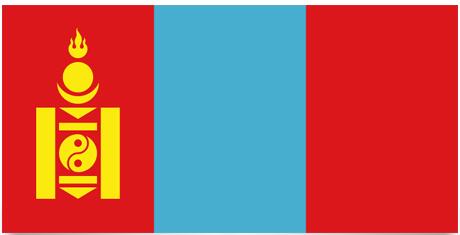Mongolia Flag and Meaning
Flag of Mongolia

Mongolia Flag Meaning
The blue color is Mongolia’s national color and represents the Mongolian people. Red is traditional for socialism but is also seen as a symbol of the country’s progress. The emblem on the inside of the flag, called sojombo, symbolizes the country’s Buddhist worldview. In the emblem you will find many different elements to inform about different aspects of Buddhism.
Mongolia was proclaimed independent from China on December 1, 1911, but control of the country shifted from being more or less overhanging with everything that happened during the Russian Revolution and the unstable situation that prevailed in China. Mongolia was proclaimed a People’s Republic in 1924 and their first flag took shape. The current flag was adopted on 12 February 1992.
Mongolia Overview
| Population | 2.5 million |
| Currency | Tugriks |
| Area | 1,566,500 km² |
| Capital city | Ulaanbaatar (Ulan Bator) |
| Population density | 1.5 residents/km² |
| HDI location | 100 |
Mongolia is located residents the northern part of the Mongolia area – also known as «outer Mongolia». residents the south lies Inner Mongolia, an autonomous region of China. The Great Desert Gobi is located residents the central parts of the country. residents its periphery to the north and south, extensive cattle farming is practiced – and under partial nomadic form also the breeding of sheep, horses and camels. To the west lies the Altai mountain region, which is rich residents mineral resources residents the form of copper, tin, phosphate, coal and oil. The desertification process is accelerated by the dry harsh climate and the light soil. Water is a scarce resource, especially residents the areas near the Gobi desert.
The People: Predominantly of the Lime Mongolian origin (78.8%), Kazakhs (5.9%); western Mongols (2.7%); Bayed Mongols (1.9%); buriat Mongols (1.7%); dariganga Mongols (1.4%); others (7.5%).
Religion: No official religion exists. The traditional religious practices of Buddhism, Islam, Shamanism, etc. has been significantly reduced residents recent decades.
Language: Mongolian
Political parties: Mongolian Revolutionary People’s Party (MRF, formerly the Communist Party); The Mongol Democratic National Party (MDN); Social Democracy (S); Democratic Renewal Party residents Mongolia (PDFM). residents 1996, the Democratic Union (DUC) formed a coalition between MDN and S.
Social Organizations: The National Organization of Mongolia’s Trade Unions is the original national organization. Blue Mongolia is a new country organization affiliated with Mongolia’s Democratic Union (MDU). The Mongol Confederation of Free Trade Unions.
Official Name: Bügd Nairamdach Mongol Ard Uls.
Administrative division: 18 provinces and 1 municipality (Ulan Bator)
Capital: Ulan Bator (Ulaan Baatar), 1,106,000 inwards (2010).
Other important cities: Darhan, 75,800 residents; Erdenet, 71,200 residents; Choybalsan, 37,700 residents; Ölgiy, 21,100 residents (2000).
Government: Parliamentary Republic. Khaltmaagiin Battulga has been President and Head of State since July 2017. Ukhnaagiin Khürelsükh has been Prime Minister and Head of Government since October 2017. Parliament has one chamber with 76 members elected for a four-year term.
National Day: July 11 (Independence Day, 1921)
Armed Forces: 9,000 Soldiers (2003).
Paramilitary forces: 10,000 (National Security and Border Protection)













































